![]()
![]()
![]()
![]()
| Discovering Our
Mezzojuso Ancestry & Heritage
|
||
| Article by Thomas Briggs |
![]()
![]()
![]()
![]()
![]() Music:
"Vero Amore"
- by Ragazzi Italiani
Music:
"Vero Amore"
- by Ragazzi Italiani![]()
![]()
![]()
![]()
![]()
![]()
![]()

![]()
![]()
![]()
![]()
Thomas Briggs - - - E-mail: briggs@clark.net
![]()
| "My Family and I Visit Mezzojuso (during July, 1990)"; |
| written shortly after our visit, and updated on 26 October 1997. |
![]()
![]()
![]()
![]()
![]()

![]()
![]()
![]()
![]()
![]()
![]()
![]()
"My Family and I Visit Mezzojuso (during July, 1990)";
written shortly after our visit, and updated on 26 October 1997.
In July 1990 my wife, daughter, sister and I had an opportunity to visit Sicily. The trip was planned merely to be a sightseeing trip to the island of birth of my paternal grandparents, Rosina Perniciaro and Gaetano Briguglio. My wife had planned an Alitalia fly and drive trip, beginning with picking up a rental car in Palermo, driving south to Agrigento, then through Piazza Armerina to Taormina, ending with driving along the north coast through Cefalł and back to Palermo.
I was not a family genealogist at the time; however, we did plan to visit Mezzojuso, my grandmother Rosina’s birthplace.
I didn’t know my grandfather Gaetano’s place of birth, only that it was somewhere in Messina Province, so we never tried to find it on this trip.
While we were in Mezzojuso this first time, we were able to find my great-great grandfather, Domenico Perniciaro’s death certificate, and I became hooked on further research into my heritage. The notes that follow pick up at the point in our trip to Sicily when we visited Mezzojuso.







The morning of July 16, 1990, we had bread, butter, jelly and the most delicious capucci we had ever had, in the restaurant of the Hotel Miravalle in Misilmeri, a town a little bit to the north of Mezzojuso. We had always heard it referred to as capuccino, but everywhere we went in Sicily it was called capucci. We left the hotel and drove down the hill and on to Highway 121.
We drove south until we saw signs for Villafrati and Mezzojuso. Grandmother Briggs, born Rosina Perniciaro in 1881 in Mezzojuso, was the daughter of Andrea Perniciaro and Lucia Fusco. Lucia was a resident of Villafrati when she married Andrea. We decided that the limited time we had would be better spent in Mezzojuso than Villafrati.
Once in Mezzojuso, we had no idea where to start, but we were interested in trying to begin at the church. The town of Mezzojuso was made of narrow streets that are difficult to drive because they are not as wide as two lanes. You have to pull over when another car wants to pass.
We made our way to the Monastero Basiliano (the Basilian Monastery, or the Monastery of Saint Basil) which we entered to look around. The custodian came up to us and asked what we wanted there. I explained in my best Italian that I was an American who was looking for information about my family which was originally from Mezzojuso. The custodian suggested that it would be best to start at the City Hall (Il Municipio, or more officially Il Palazzo Municipale). The custodian was very helpful and also volunteered to show us the alter of the Church (Maria Santissima di Tutte le Grazie; Most Holy Mary of All Graces), which was originally Greek in origin. Just as we were about to leave to go to the City Hall, an official Italian government visitor arrived at the monastery. He had several Carabinieri bodyguards and was dressed in a uniform. We couldn't tell if he was an army officer or an officer of the Carabinieri.
![]()

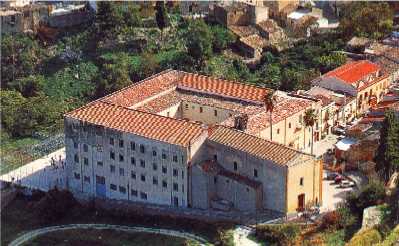

Maria Santissima di Tutte le Grazie, Mezzojuso's most ancient Byzantine-rite church previously called Vergine Maria Gloriosissima, whose Papįs welcomed Mezzojuso's first Albanian settlers in the 1460s. Attached is the large quadrangular Monastero Basiliano, founded in 1609 through a bequest by the Arbėresh noble Andrea Reres.
Photo: Courtesy of Giovanni Tavolacci, a Mezzojuso resident.
![]()

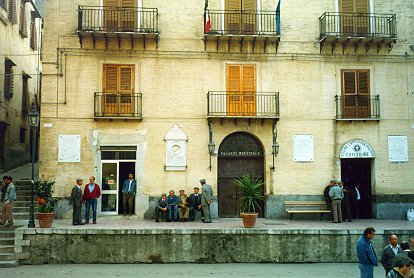
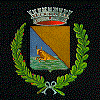
Il Palazzo Municipale, Mezzojuso's City Hall, can also be simply called Il Municipio.
Photo: Courtesy of John Tantillo, a Mezzojuso descendant in the USA.
![]()
We drove to the vicinity of the City Hall, parked the car two or three blocks away, and then walked. We found two clerks who were willing to help us, although neither of them spoke English. One of the clerks understood some English words, but there was no way to use English to communicate. Again, I tried my best Italian to explain what we wanted. The clerk was able to find birth certificates for Rosina Perniciaro and Giuseppa Lo Monte. Giuseppa, born in 1823, was the wife of Domenico Perniciaro, born in 1815.
Domenico Perniciaro and Giuseppa Lo Monte (my second great-grandparents) were the parents of Andrea Perniciaro, husband of Lucia Fusco (of Villafrati).
Andrea Perniciaro and Lucia Fusco (my first great-grandparents) were the parents of my grandmother, Rosina Perniciaro.
Unfortunately, the City Hall records only went back as far as 1820, so it was not possible to find any record of Domenico Perniciaro's birth. We did, however, find his death certificate, since he died in Mezzojuso in 1899.
Domenico Perniciaro's parents, listed on the 1899 death certificate, were Andrea Perniciaro and Rosa Arena (my third great-grandparents). There was no other identifying data.
Giuseppa Lo Monte's birth certificate listed her father as Francesco Lo Monte, 40 years old, and her mother as Domenica Chetta, 36 years old (also my third great-grandparents). Since Giuseppa was born in 1823, that would make Francesco's birth in about 1784 and Domenica's in about 1788. At the time of her death, Giuseppa was described as an "industriosa," which we think may have meant housewife.
When the clerk saw the name Domenica Chetta, he expressed the opinion that she may have been Albanesi in origin. There was at least one famous Albanesi named Chetta, and it seems the clerk was basing his opinion on the fact that Chetta is an Albanesi name.










There was a migration of Albanesi Greeks to Sicily in the 15th century. Mezzojuso was one of the towns that some of the Albanesi settled in, and, to be sure, the evidence is still there. There are two churches in the main square of the town. One is Roman Rite Catholic (Maria Santissima Annunziata; Most Holy Mary of the Annunciation), and the other is Greek Rite Catholic (San Nicola di Mira; Saint Nicholas of Mira).
It is interesting to note that a member of the Perniciaro family from Mezzojuso was a very high ranking priest of the Greek church. We heard him (Bishop Giuseppe Perniciaro) being referred to once as Bishop and once as Cardinal.
![]()

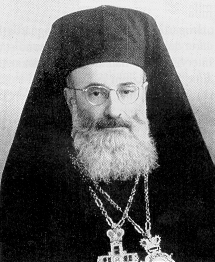

| Bishop Giuseppe Perniciaro (11 January 1907 - 5 June 1981): |
| The greatly admired Bishop of the Italo-Albanian [Arbėresh] Byzantine-rite |
| Catholic Eparchy of Piana degli Albanesi, 1967-1981. |
Photo: Courtesy of "Eco della Brigna", bimonthly publication of Mezzojuso.
![]()
| BISHOP GIUSEPPE
PERNICIARO The third issue of "Eco della Brigna" (March 1998) featured several articles on Mezzojuso's unique bi-ritual Byzantine and Roman Rites (both rites are within the Catholic church). Here is a short biographical article dedicated to Bishop Giuseppe Perniciaro, who was born in Mezzojuso and who was instrumental in the implementation and development of the Eparchy of Piana degli Albanesi, founded in 1937 for the Italo-Albanians (Arbėresh) as Byzantine Rite Catholics. |
Giuseppe Perniciaro nasce a Mezzojuso l'11 gennaio 1907. Dopo aver frequentato per cinque anni il seminario greco di Palermo, entra a quattordici anni nel Collegio Greco di Roma. Nel 1928 consegue la laurea in Teologia e quindi la specializzazione in Scienza Ecclesiastiche orientali. |
Giuseppe Perniciaro was born at Mezzojuso on 11 January 1907. After having attended for five years the Greek seminary of Palermo, he enters at age fourteen the Greek College in Rome. In 1928 he is conferred the laureate in Theology and then the specialization in Eastern Ecclesiastic Science. |
|
Viene ordinato sacerdote il 7 luglio 1929. Nel 1932 diviene rettore del Seminario Greco di Palermo. Il 26 ottobre 1937 viene eletto Vescovo e consacrato il 16 gennaio 1938. |
He is ordained a priest on 7 July 1929. In 1932 he is appointed as the rector of the Greek Seminary of Palermo. On 26 October 1937 he is elected Bishop and is consecrated on 16 January 1938. |
|
Instituita la Diocesi di Piana degli Albanesi, ne diviene Vescovo ausiliare (essendone titolare l'archivescovo di Palermo). Nel 1967 diventa vescovo titolare della nostra Diocesi. |
Upon the institution of the Diocese of Piana degli Albanesi, he becomes the Auxiliary Bishop (being titled as archbishop of Palermo). In 1967 he becomes the Titular Bishop of our Diocese. |
|
La sua attivitį pastorale all'interno dell'Eparchia e' sempre coniugata con quella ecumenica, per l'abbattimento di barriere storico-culturali e per la conoscenza diretta della tradizione orientale. Muore a Piana degli Albanesi il 5 giugno 1981. |
His pastoral activity for the entire Eparchy is always joined together with that of ecumenical (activity), in order to knock down historical-cultural barriers and for the direct understanding of the Eastern (rite) tradition. He dies at Piana degli Albanesi on 5 June 1981. |
|
Mezzojuso ricorda ancora con devozione "il Vescovo" per eccellenza, come ricorda ancora la sentita partecipazione ai suoi funerali, forte momento di testimonianza di unitį ecclesiale. |
Mezzojuso still remembers with devotion "the Bishop" par excellance, as it still recalls its touching participation at his funerals, a strong moment of testimony to ecclesial unity. |
![]()
I was able to get a copy of Domenico's death certificate, but did not get copies of any of the birth certificates. The copy machine was ancient and dilapidated and, while the clerk was very helpful in volunteering to make one copy, I did not want to impose on his good will by asking to make copies of everything.
The clerk also gave me and my sister copies of a book entitled "Manzil Jusuf," written by Ignazio Gattuso and published by the Biblioteca Comunale "G. Buccola" in Mezzojuso. This book describes the origin of the name of the town and gives background to the immigration of the Albanesi into Mezzojuso. One theory of the author is that Mezzojuso derives its name from the Saracen Arab name "Manzil Jusuf" or "Menzil Yusuf" which meant "the village of Joseph", who was Abu al Fath Jusuf, the Emir of Sicily at the time (11th century). All of Sicily. and more so Mezzojuso, has been strongly influenced by Saracen Arab culture. First Greeks (prior to the 10th century) and then the Saracens (in the 10th and 11th centuries) ruled large parts of Sicily, followed by French Normans, and German Swabians (from Baden Wuerttemberg).
Having spent the entire morning in the City Hall, it was time for lunch, and the two clerks were looking forward to closing for lunch and leaving. I asked the clerk where we could have lunch, and rather than trying to give us directions, he telephoned the restaurant and the owner's son-in-law agreed to come to the City Hall to guide us to this restaurant.
My sister and I thanked the clerk and went down the stairs to the entrance to the City Hall to join my wife and daughter, to wait for the restaurant guide. My wife and daughter were hiding just inside the door, staying clear of a crowd of young men who were clustered just outside the doorway. It turned out that they were all interested in seeing the Americans who had come to Mezzojuso to find their relatives. One of the young men (Nick) was an American who had been born in Mezzojuso but now lived in Long Island. He and his father were in Mezzojuso to visit his grandmother, who had been born in the United States but now lived in Mezzojuso. The young man spoke English with a typical Nooyawk accent and spoke fluent Sicilian. He told us that one of the young men standing around the door had heard that we were Perniciaro's and wanted to meet his American cousins. I shook hands with him, and he seemed satisfied.
When the restaurant guide arrived, Nick interpreted and helped everyone understand that we would go get our car and then meet the guide in front of the City Hall before following him to the restaurant. The restaurant seemed to be the only one in Mezzojuso. It was called the Delfino (Dolphin) Ristorante and was operated by a mother and her daughter. It turned out that they had lived in Belgium for 5 years and both spoke French. This made it easier for us to communicate with them, because my wife spoke much better French than I spoke Italian or they spoke English. We had a delicious spaghetti lunch with some of the owner's home-made red wine, and fruit for dessert. She gave us a bottle of her home-made wine in a one liter plastic Coke bottle. (The wine lasted us another two days before we had to throw away the last of it. It was totally natural wine and could not stand the intense heat in the trunk of the Fiat rental car.) We told the owner that we wanted to visit the town cemetery, and she gave us directions. It was only about a half-mile from the restaurant.

![]()

![]()
![]()
![]()

![]()

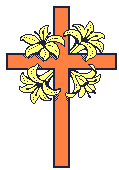
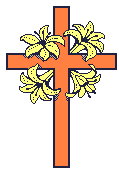
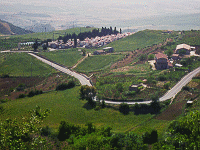


Several views of Mezzojuso's Cemetery -- a mile east of the comune:
Cemetery as seen from afar, at its main gate, at a mausoleum within the cemetery.
The Cemetery of the town of Mezzojuso has a very large number of Perniciaro's and Lo Monte's buried in it. When you think that Andrea Perniciaro was one of 23 children and the only one to emigrate to the United States, we must have a lot of cousins still living there, as well as being related to the Perniciaro's buried in that cemetery. The cemetery is not open every day and has limited hours on the days that it is open. We arrived about an hour before closing.
After wandering around the cemetery for 45 minutes, I approached the caretaker, who was hanging around at the entrance gate anxious for everyone to leave so he could close up. When I explained that I was an American looking for records of my relatives, the caretaker went into the cemetery office to get the "log book". This book contains a chronological record of every one buried in the cemetery, but only from the end of the 1890's. If you know when someone died, and as long as it is later than the 1890's, he can find the plot number. Even though Domenico Perniciaro died in 1899, the caretaker could not find any record for him nor of Giuseppa Lo Monte. Since the 1890's, most people were buried in a type of mausoleum. Most had photographs of the deceased, preserved under glass, and the names cut into the stone were legible. Those not buried in mausoleums but with free-standing markers, were hard to read as the lettering was weather-worn. We did not have any luck looking for names on this type of grave marker.
We finally gave up, thanked the caretaker, and left. We did take a small rock from the cemetery to keep a piece of the earth from our "home town". We decided at this point that we had done all we could in Mezzojuso. We then drove south on Highway 121, and then turned off onto Highway 189 for Agrigento on the southern coast of Sicily.







After making our sightseeing trip through Agrigento, Piazza Armerina and Taormina, we returned to Palermo and I asked my wife, daughter and sister if they wouldn’t mind returning to Mezzojuso. The genealogy bug had begun to eat at me after departing Mezzojuso, and I had questions I wanted to pursue by going back for another visit.







On Friday, July 20, 1990, we left Mezzoforno and drove back to Mezzojuso. I had time to think about the first visit and decided to go back and try to uncover more information, especially by visiting the Roman Rite Catholic church. Since my wife and daughter did not want to go along, they decided to stay with the car and read, while my sister and I went off to search for our roots. I found a parking place in the shade, and left my wife and daughter to their own devices. It was only about 3 or 4 blocks from the parking place to the main Town Square (named officially as Piazza Umberto Primo, or Humbert the First Plaza, after Italy's second modern monarch of the late 1800s; called informally as "la chiazza" in the local dialect of Mezzojuso).
My sister and I walked up to the Roman-rite Catholic Church (Maria Santissima Annunziata; Most Holy Mary of the Annunciation) and tried the front door but it was locked. There was a woman who appeared to be in her 30s, standing at the top of the steps. I asked her in Italian if she spoke English, Spanish or German. She answered that she only spoke Italian and Sicilian. I tried to ask her if she knew when the church would be open, but it soon became apparent that she may have been slightly demented. She began to ramble on in Italian, and there was no way to know what she was saying or even if she was talking to my sister and me.
I suggested to my sister that it might be a good idea to move on and to try something else. Right across the main plaza (Piazza Umberto Primo, called locally "la chiazza") from the two churches (Roman Rite Catholic church of Maria Santissima Annunziata and Greek Rite Catholic church of San Nicola di Mira) was a bank. I thought that perhaps someone working in a bank might be able to speak another language besides Italian and Sicilian.
![]()
![]()
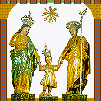
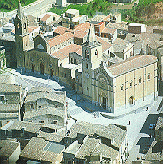
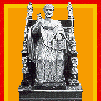
![]()
Mezzojuso's Center: Humbert the First Plaza (known locally as "la chiazza"), at whose northern perimeter are located the two matriarchal Catholic churches -- [left] Most Holy Mary of the Annunciation (of the Latin / Roman Rite; rededicated in 1572; founded as Most Holy Glorious Mary at about 1072, by the Normans); and [right] Saint Nicholas of Mira (of the Greek / Byzantine Rite; founded in 1516, by the Italo-Albanians / Arbėresh).
![]()
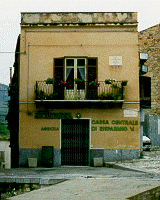
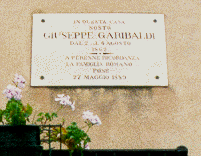


![]() General
Giuseppe Garibaldi in Mezzojuso, 2-4 August 1862.
General
Giuseppe Garibaldi in Mezzojuso, 2-4 August 1862.![]()

Left: House of Francesco Spallitta, an avid Risorgimento supporter, at whose home the famous General Garibaldi stayed; this building presently houses Mezzojuso's only bank. Center: Commemorative Plaque, noting that Giuseppe Garibaldi visited here in Mezzojuso, during 2-4 August 1862. Right: Photo of General Giuseppe Garibaldi (1807-1882).
![]()
Upon entering the Bank, I discovered that it was very small with only a narrow area in front of the teller windows. It was rather crowded with customers, and everyone (customers and bank employees) turned to stare at my sister and me. I tried to ask in Italian if anyone knew when the church would be open. One of the tellers asked why I wanted to know, and I tried to explain that I wanted to talk to the priest about finding information about my relatives. The teller asked what my name was. Since I was looking for Perniciaro information, it was easiest to say my name was Perniciaro. The teller then said that one of the women customers was a Perniciaro, and she came and began talking to me in Sicilian.
At this point, it seemed a good idea to get out of the narrow confines of the bank and back into the street. Out of the bank, I was trying to make sense of what the woman was saying, when more people crowded around, and someone said that another Perniciaro was there.
Giuseppe Perniciaro introduced himself, and I asked if he spoke English, Spanish or German. He did not, but another man in the group said that he spoke German. I then was able to explain in German, through the second man, to Giuseppe Perniciaro that I was looking for information about my Perniciaro relatives and needed help in talking to the priest. Giuseppe agreed to help and went to the side door of the Roman-rite Catholic Church and buzzed the priest. He answered over the intercom, and when Giuseppe told him what he wanted, the priest said that he was too busy and asked Giuseppe to come back at 3:00 p.m. After Giuseppe and I discussed this development, Giuseppe said that he had other business to conduct and hoped that I would be able to see the priest at 3:00 p.m.
Giuseppe left, and my sister and I weren't sure what to do next. We walked slowly through the plaza, talking it over, and when we reached the main street in front of the City Hall, I spotted Giuseppe standing in front of a shop. I decided to talk to Giuseppe again and asked him if he knew anyone in Mezzojuso who spoke English. Giuseppe invited my sister and I into a shop that seemed to be a grocery store and soda fountain. He invited us to have a cold drink, while he went out and conferred with some of his friends. He came back and said that we should look for Nick Musacchia who was an American visiting Mezzojuso, who could speak both English and Sicilian. Since I suspected that this might be the young man who had been outside of the City Hall on our first day in Mezzojuso, I memorized Giuseppe's instructions and set off to find Nick.
My sister and I walked back up the main street and past the City Hall and turned right at the traffic light, to walk up a flight of stairs that were part of a street that cars could not travel. At the top of the stairs where you could only turn right or left, we turned left and found a grocery store. Giuseppe said, to ask in the store to find Nick. The storekeeper asked why I was looking for Nick. When I explained, mentioning that I was seeking information about the Perniciaro family, the storekeeper took me out into the street and called up to a woman standing in a balcony across the street from the grocery store. She went inside and came out with an older man. He listened to the grocery clerk, and then told the clerk to bring us around to the door.
At the door, the man introduced himself as Salvatore Musacchia, who was Nick's father. Soon, Nick came down and I reminded him that we had met at the City Hall on the previous Monday. Salvatore invited us to go up to their house. Inside, we also met Salvatore's mother who lived in Mezzojuso. The mother was actually born in the United States, but spoke no English. Salvatore was born in Long Island, but spoke English with a heavy Italian accent. Nick was born in Mezzojuso, now lived in Long Island and spoke English perfectly. Evidently, the Musacchia family never severed connections with Mezzojuso, as had the Andrea Perniciaro family. We were served coffee, while all this discussion was going on. Nick said that he had to go to Palermo and could not help, but Salvatore said that he would try to help us out.
It turned out that Salvatore Musacchia and Giuseppe Perniciaro were childhood friends, and Salvatore found Giuseppe in the main plaza. After some discussion about the priest and the church, Salvatore explained that he did not think that the priest would be very cooperative since he was not from Mezzojuso. Since I felt that I had to have a native Italian-speaking capability in order to speak to the priest, I decided not to pursue visiting the church.
I asked Giuseppe Perniciaro if I could write a letter to him, after returning to the United States, if the letter were written in Italian. I said that I would find someone to help me write a letter in Italian, and got Giuseppe's address from him. Giuseppe, Salvatore and I all posed together, for a photograph taken by my sister.


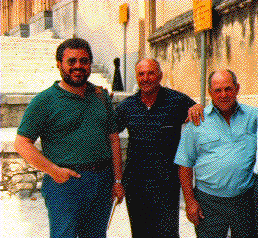


| Thomas Briggs, Giuseppe Perniciaro and Salvatore Musacchia: |
| posing together in front of Mezzojuso's two matriarchal Catholic churches, |
| at Piazza Umberto Primo (known locally as "la chiazza"). |
| Photo: Courtesy of Thomas Briggs, a Mezzojuso descendant in the USA. |
Leaving Mezzojuso, we drove back toward Palermo on Highway 121, and about 20 kilometers from Mezzojuso stopped for lunch.



![]()
![]() Arrivederci, Mezzojuso
Arrivederci, Mezzojuso![]()
![]()
Tommaso ![]() Briggs
Briggs
![]()
![]()
"Briggs Personal Pages" -- by Thomas Briggs
![]()
![]()
![]() http://www.digiserve.com/briggs
http://www.digiserve.com/briggs![]()
![]()
![]()
![]()
Tom presents this multi-faceted website, about his various interests, particularly his genealogical researches (in Sicily, southern Italy, Greece and Ireland), that include in part his Mezzojuso family roots and heritage, and his reviews on child abandonment in Western Europe, Italy and Mezzojuso.
![]()







After returning to the United States, I found the Italian Assistant translation program and was able to write a letter to Giuseppe Perniciaro in Italian. Giuseppe wrote back to me and sent me an envelope full of copies of birth and death records for my grandmother’s siblings and parents. We exchanged several letters and then our correspondence lapsed. I visited Mezzojuso again in May 1997, and found out that poor Giuseppe had died, the victim of a rather unfortunate and painful sickness. I have not yet determined if he was a relative, but he was a kind and generous man.
   |
Requiescat in Pacem. |
   |
![]()
![]()
![]()
![]()
![]()
![]()





![]()
![]()
Discovering Our Mezzojuso Ancestry & Heritage
Blackburn, Mollye Bilao - - - "A Little of My Family History, and My Visit to Mezzojuso"; written on 20 April 1997. - - - "Cucidate: Fig Cookies for Christmas, A Mezzojuso Recipe"; written on 15 December 1997.
Briggs, Thomas - - - "My Family and I Visit Mezzojuso (during July, 1990)"; written shortly after the visit, and updated on 26 October 1997.
Cusimano, John - - - "My Trip to Mezzojuso (in the Province of Palermo)"; written on 7 November 1994.
De Angelo, Thomas - - - "My 'Discovery' of Mezzojuso"; written on 29 November 1999.
Di Stefano, Richard - - - "My Mezzojuso Immigrant Ancestors (Who Arrived in the U.S.A. in 1890)"; written on 1 November 1997.
Dunne, Laura Cutaia - - - "Genealogical Research on My Family from Campofelice di Fitalia"; written on 25 March 1999.
Frasca, Anthony - - - "Our Mezzojuso Reunion"; written on 10 May 1999.
Gallo, Frank - - - "Coincidence or Destiny? An Amazing Surprise during My Mezzojuso Research"; written on 29 April 1998.
Lagattuta, Salvatore Joseph - - - "My Family History from Mezzojuso"; written on 8 October 1999.
Lagattuta, Salvatore Joseph - - - "Remembrance of Visiting Mezzojuso (during the Summer of 1969)"; written on 26 April 1997.
Schiró, Anthony - - - "Mezzojuso Memories: Researching My Ancestry"; written on 26 October 1997.
Tavolacci, Giovanni - - - "I Soldati Garibaldini da Mezzojuso nel 1860" - "Garibaldi's Soldiers from Mezzojuso in 1860"; written on 12 April 1999. - - - "Campofelice di Fitalia e Mezzojuso" - "Campofelice di Fitalia and Mezzojuso"; written on 12 April 1999.
Mezzojuso's Descendents and Friends
|




![]()

![]()




![]()
![]()
![]()

![]() Home Page
Home Page![]() Main
Menu
Main
Menu![]() Discovering
Our Mezzojuso Ancestry
Discovering
Our Mezzojuso Ancestry![]()

![]()
![]()
![]()